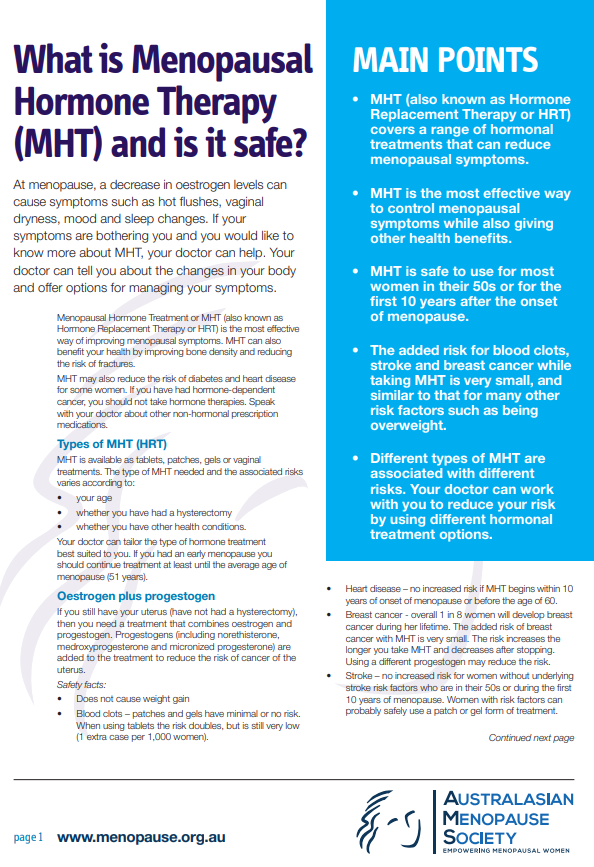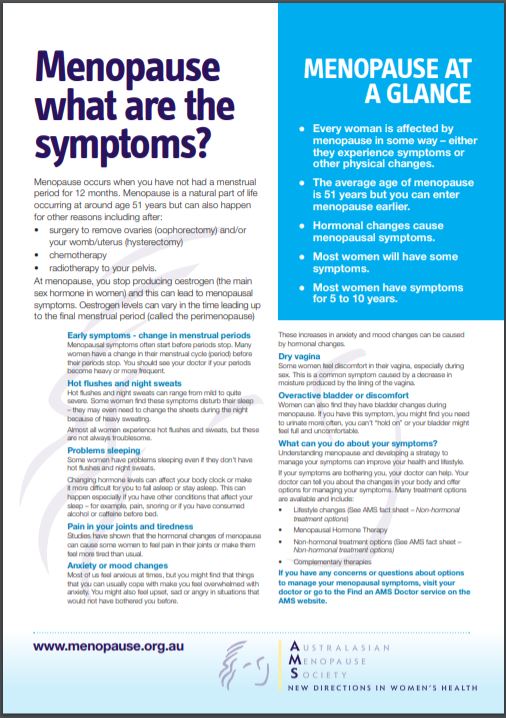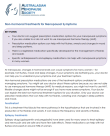Menopausal hormone therapy
Previously called HRT or hormone replacement therapy
Key points about menopausal hormone therapy (MHT)
- Menopausal hormone therapy (MHT) covers a range of hormonal treatments that can reduce menopausal symptoms.
- MHT is available as tablets, patches, gels or vaginal treatments.
- If you have menopausal symptoms that affect your quality of life and want to know what treatments could help, talk to your healthcare provider.

Menopausal hormone therapy (MHT) is the use of hormone treatments to replace oestrogen. It can help to relieve some of the symptoms of menopause and can make a big difference to the quality of life for many people.
Menopause happens when you stop menstruating (having periods) due to changes in hormones (oestrogen and progesterone) made by your ovaries. You are said to have reached menopause when you haven't had a period, or spotting, for 12 months.
The years leading up to menopause are called perimenopause and during this time you may notice changes in your periods and you may also have other symptoms such as irritability and other mood changes, poor sleep, sweats or flushes, aches and pains, skin changes, heart palpitations or ‘brain fog’ (poor memory or losing your words).
Menopause affects people in different ways and symptoms vary hugely in severity. You may have very little discomfort, or you may find that your symptoms interfere with your relationships and normal daily activities. If you have symptoms that are not relieved by lifestyle adjustments and self-care measures, your healthcare provider will discuss various treatment options with you, including MHT.
What are the benefits of MHT?
MHT is an effective way of improving menopausal symptoms. For example, MHT has been found to:
- reduce the number and severity of hot flushes and night sweats
- improve symptoms of vaginal dryness and soreness and help reduce recurrent urine infections
- help with anxiety, irritability and mood disturbance.
Without treatment, menopausal symptoms such as hot flushes, night sweats, sleep problems and headaches may last for a few years. About 10% of women still have symptoms that bother them 10 years after their last period.
MHT can also improve bone density and reduce the risk of fractures, if you are at risk of thinning bones (osteoporosis) because it keeps your bones strong.
MHT may also reduce the risk of diabetes and heart disease for some women. During menopause, as oestrogen levels drop, the level of fat in a woman's blood can increase. These changes put women at risk for developing heart and circulatory system disorders such as high blood pressure, high cholesterol, stroke and heart disease. Read more about what you can do to reduce your risk of heart disease.
MHT contains different hormones – oestrogen, progestogen or both. MHT can be taken or used in different ways such as tablets, patches or gel.
The type of MHT needed, and any associated risk, varies according to your age, whether you have had an operation to remove your womb or uterus (hysterectomy) and whether you have other health conditions. Talk to your healthcare provider about your symptoms and your personal medical history. This will guide the treatment best suited to you.
If your symptoms are mainly related to vaginal dryness, urinary symptoms and pelvic floor problems
Applying oestrogen to your vagina, in the form of Ovestin vaginal cream or pessaries, may be more suitable for these symptoms because it's designed to work mainly in your vagina, bladder and pelvic floor. Vaginal oestrogen can help reduce your risk of UTIs as well as helping with vaginal symptoms. It's very safe, even if you've had breast cancer. Vaginal oestrogen can be used alone or with MHT and it doesn't need to be used with any progestogen even if you still have a uterus. Read more about oestrogen vaginal cream and pessaries.
If you have a uterus
It’s important that you use both oestrogen and progestogen for your MHT. Taking oestrogen tablets, patches or gel alone can cause thickening of the uterus lining (endometrium) which can increase the risk of endometrial cancer. Taking progestogen helps to prevent the thickening of the lining and therefore reduces the risk of cancer.
If you’ve had a hysterectomy (your uterus has been removed)
You can use oestrogen alone and you don’t need progestogen, unless you've been diagnosed with endometriosis. If you have endometriosis, there may be some womb lining (endometrium) remaining hidden elsewhere in your body such as your bowel or bladder. Taking a continuous low dose of progesterone protects it from being stimulated by oestrogen.
Differences between oestrogen tablets, patches and gel
Oestrogen tablets, patches and gel are absorbed into your bloodstream and can work in hormone receptors in different parts of the body including your uterus (womb), bladder, heart, bones, skin, muscles and brain. Oestrogen patches or gel, deliver oestrogen through the skin directly to the bloodstream and bypass the liver. They are generally considered safer because they don't increase the risk of blood clots. Oestrogen tablets have to be processed by the liver, which can alter the production of proteins involved in blood clotting.
Cost
Cost is an important factor when choosing MHT. The cost you pay for medicines on prescriptions in Aotearoa New Zealand depends on whether the medicine is fully subsidised, partially subsidised, or not subsidised. Here are a few examples.
- Fully subsidised oestrogen options include Ovestin vaginal cream, Ovestin pessaries, Estrogel, oestrogen patches (Estradot, Climara, Mylan), oestrogen tablets (Progynova).
- Partially subsidised means you need to pay for the prescription charge and part of the medicine. Examples include Estrofem, Premarin, Kliovance, Kliogest and Trisequens.
- Unsubsidised medicines means you'll need to pay the full cost. How much you pay depends on how much the medicine costs plus any dispensing fee and mark up charged by the pharmacy. The final price can vary, so it's best to check with the pharmacy first. When you are checking the cost, make sure you tell the pharmacy the exact name and strength of the medicine and how much you need.
Note, subsidised brands can change each month, so the list above may not be up-to-date. Read more about prescription charges
Oestrogen alone
Oestrogen alone is suitable if you've had an operation where your uterus has been removed (hysterectomy), unless you have had a previous diagnosis of endometriosis. If you have been diagnosed with endometriosis, you will need oestrogen plus progestogen (see below).
Oestrogen is available as different products and in different strengths.
- Tablets such as Progynova, Estrofem, Ovestin, Premarin.
- Patches such as Estradiol, Estradot and Estraderm MX, Lyllana Estradiol.
- Gel such as Estrogel.
Safety considerations of oestrogen alone
- Blood clots: Oestrogen patches and gel have minimal or no risk. When using tablets, the risk doubles, but it's still very low (1 extra blood clot per 1000 women).
- Heart disease: MHT may decrease the risk of heart disease if started within 10 years of menopause or before the age of 60.
- Breast cancer: Overall 1 in 8 women will develop breast cancer during their lifetime. Studies suggest there's either no increase, or a very small increased risk of breast cancer when using oestrogen-only MHT. Breast cancer risk is lower with oestrogen-only MHT compared with oestrogen plus progestogen. Read more about breast cancer risk(external link).
- Stroke: There's no increased risk if you don’t already have risk factors for stroke and you're in your 50s or during the first 10 years of menopause. If you have risk factors you can probably still safely use oestrogen patches or gel.
Vaginal oestrogen cream or pessaries (Ovestin cream® and Ovestin pessaries®)
If your symptoms are mainly related to vaginal dryness, urinary symptoms and pelvic floor problems, applying oestrogen directly to your vagina may be more suitable. Vaginal oestrogen can reduce symptoms such as vaginal dryness, burning, and itching of the vaginal area. It may reduce symptoms of urinary urgency (the sudden, strong need to urinate) and irritation when peeing and also decrease the risk for urinary tract infections.
- It's designed to work mainly in your vagina, bladder and pelvic floor.
- The oestrogen levels in your blood aren't raised significantly, which minimises the effect of oestrogen in other areas such as your breast or uterus.
- Vaginal oestrogen can be used alone or with MHT.
- It doesn't need to be used with any progestogen even if you still have a uterus. Read more about oestrogen vaginal cream(external link).
- It's safe if you've had a past diagnosis of breast cancer.
Oestrogen plus progestogen
Progestogen is the synthetic (human-made) form of progesterone, which occurs naturally in the body. If you still have your uterus, your MHT will include both oestrogen and progestogen. This is because oestrogen alone can overstimulate the cells lining your uterus, causing an increased risk of cancer of the uterus lining. So if you have a uterus you will need to take progestogen together with oestrogen to reduce the risk.
If you’ve had a hysterectomy but have been diagnosed with endometriosis, you will need both oestrogen and progestogen. This is because there may be some womb lining (endometrium) remaining hidden elsewhere in your body such as your bowel or bladder. Taking a continuous low dose of progesterone protects it from being stimulated by oestrogen.
Examples of progestogen-only products include:
- Tablets: Norethisterone (Primolut N), medroxyprogesterone (Provera)
- Intrauterine device (IUD): Mirena which contains levonorgestrel
- Capsules: Utrogestan
Note: Utrogestan is considered a body identical hormone therapy because it has the same chemical structure as the natural female hormone progesterone. Evidence suggests that this formulation has fewer long-term side effects or risks, as compared to synthetic progestogens (norethisterone, medroxyprogesterone, levonorgestrel). Progestogens must be taken with oestrogen-only products.
Combination tablets
Some products have both oestrogen plus progestogen in a single tablet such as Kliogest, Kliovance and Trisequens.
Note: These medicines are partially funded in New Zealand. This means you need to pay for the prescription charge and part of the medicine, the government subsidises the rest.
Safety considerations for oestrogen plus progestogen
- Blood clots: Patches and gel have minimal or no risk. When using tablets the risk doubles, but it's still very low (1 extra blood clot per 1,000 women).
- Heart disease: There's no increased risk if MHT is started within 10 years of the start of menopause or before the age of 60.
- Breast cancer: Overall 1 in 8 women will develop breast cancer during their lifetime. The added risk of breast cancer with MHT is very small. The risk increases the longer you take MHT and decreases after stopping it. Some types of progestogens such as Utrogestan have lower risk.
- Stroke: There's no increased risk if you don’t already have risk factors and you're in your 50s or during the first 10 years of menopause. If you have risk factors you can probably safely use a patch.
- MHT with oestrogen and progestogen doesn't cause weight gain.
Tibolone (also called Livial)
Tibolone isn’t oestrogen or progestogen, but it has similar effects. Tibolone can be used if you still have your uterus and haven't had a natural period for at least 1 year. It comes as a tablet that's taken once a day.
Note: Tibolone is not funded in Aotearoa New Zealand.
- Tibolone can reduce the risk of osteoporosis (thinning of the bones) in post-menopausal people.
- It doesn't cause an increase in blood clots, heart disease or breast cancer. It reduces breast tenderness and there is no evidence of an increase in breast cancer risk with 3 years of use.
- It increases the risk of stroke if started after the age of 60.
- Read more about tibolone.(external link)
MHT is safe to use for most people if started in their 50s or for the first 10 years after the onset of menopause.
If you had an early menopause (before 45 years) you should continue treatment at least until the average age of menopause (51 years).
When assessing the risks of MHT, remember that they're not the same for everyone. Your healthcare provider will be able to discuss your individual risk with you.
- Risks vary based on how old you are, when you start MHT and how long you take it for.
- Short-term use in early menopause has fewer risks than when it's started later in menopause.
- Risks generally increase as you get older.
MHT and cancer risk
Women are often concerned about the risk of cancer when using MHT. If you're concerned, talk to your healthcare provider about your situation.
Here is some guidance.
- Breast cancer: Fear of breast cancer is a major reason why women don't use MHT. Postmenopausal women are more likely to die from heart disease or stroke than breast cancer. Overall 1 in 8 women will develop breast cancer during their lifetime. Studies suggest there's either no increase, or a very small increased risk of breast cancer when using oestrogen-only MHT. Breast cancer risk is lower with oestrogen-only MHT compared with oestrogen plus progestogen. The risk increases the longer you take MHT and decreases after stopping it. Some types of progestogens such as Utrogestan have lower risk. Read more about breast cancer risk(external link).
- Endometrial cancer: Oestrogen-only MHT increases the risk if you have a uterus, because oestrogen stimulates the endometrial lining. That’s why progestogen is added to protect your uterus. Combined MHT (oestrogen + progestogen) protects against endometrial cancer, when used continuously.
- Ovarian cancer: There is a very low risk that MHT increases the risk of ovarian cancer. The absolute risk of ovarian cancer associated with MHT use is low, with about 1 additional case per 1,000 women using MHT for 5 years.
MHT after treatment for cancer
Women often have concerns about starting MHT after having cancer treatment. Your suitability to start MHT depends on the type of tumour you have.
- Cervical, vaginal and vulval cancers: Using MHT is generally suitable if you’ve had these cancers, as they're not considered hormone responsive cancers. This means these types of cancers don't rely on hormones (such as oestrogen or progesterone) to grow or spread.
- Endometrial cancer: MHT is reasonable for those who have had surgery (removal of uterus and both ovaries) for low-risk endometrial cancer to use oestrogen replacement, with either the patch, gel or tablets. Progesterone is rarely required – your gynaecologist will advise you. Note: You will not need progestogen because your uterus has been removed.
- Ovarian cancer: MHT treatment depends on whether you have had surgery to remove your uterus. In some types of ovarian cancers, MHT can be considered after weighing up the risk and benefits. It's important you discuss this with your gynaecology oncologist before starting MHT
- Breast cancer: For women who have had hormone receptor-positive breast cancer, MHT is not usually recommended. Non-hormonal treatments are preferred.
Timing: If you have recently had surgery, the best time to commence MHT is anytime 6 weeks after surgery.
Use of oestrogen vaginal cream and pessaries (Ovestin cream and pessaries)
- Vaginal oestrogen is used to ease vaginal, vulval and urinary symptoms of menopause such as vaginal dryness, burning or itching. These products increase the levels of oestrogen in your vaginal area which helps relieve symptoms. It's designed to work mainly in your vagina, bladder and pelvic floor. The oestrogen levels in your blood aren't raised, which minimises the effect of oestrogen in other areas such as your breast or uterus.
- It's safe for women who have a past diagnosis of endometrial, cervical or ovarian cancer.
- If you have had breast cancer, vaginal oestrogen is generally considered safe, so talk to your healthcare provider about whether it’s an option for you.
- Read more about vaginal oestrogen.
Most MHT options do not provide contraception. Contraception is still recommended for 2 years after your last period if you're under the age of 50, and for 1 year after your last period if you're over 50.
- A Mirena IUD (contraceptive device that sits in the uterus) works as contraception to prevent pregnancy. It can also provide the progestogen component of MHT.
- Ask your doctor or nurse prescriber about suitable contraception options if needed.
Every person is different and the length of time you'll have menopausal symptoms is unknown. It’s important to have regular check-ups with your healthcare provider to assess whether ongoing MHT is right for you.
- People who go through menopause before 45 years of age are advised to take oestrogen therapy until the average age of menopause – about 51 years of age.
- MHT is safe to use for most people in their 50s or for the first 10 years after the onset of menopause.
- Most people stop taking it after a few years, when their symptoms improve. It's usually best to reduce MHT gradually rather than stopping it suddenly. This may reduce the risk of menopausal symptoms returning.
- Some people choose to take MHT for much longer, for example if they have low bone density or find their symptoms return when they stop it. This decision is for each person to make for themselves, discussing the risks and benefits, with their healthcare provider.
Many people consider using complementary therapies such as phytoestrogens.
- Some complementary medicines may help some people with mild symptoms, but there is little clinical evidence to support their use.
- Avoid buying online products – their safety can't be guaranteed.
- You shouldn't use soy/phytoestrogen products if you can’t take prescribed hormone therapy for safety reasons (eg, breast cancer).
- Complementary therapies can also cause side effects and may interact with prescription medicines, so tell your doctor, nurse prescriber or pharmacist if you're using or planning to use these.
- Read more about complementary medicine options for menopausal symptoms(external link).
You may want to consider non-hormonal treatments if you don't want MHT, or if you're unable to take it. There are some lifestyle changes such as improving your diet, exercising and stopping smoking which may help to reduce your menopausal symptoms.
Other possible treatments for menopause symptoms include:
- Some antidepressants (usually low doses) can help with severe hot flushes and sweats.
- Other medicines may help with severe hot flushes and sweats. Talk to your doctor or nurse prescriber about these.
- High blood pressure medication can help with mild menopausal symptoms.
- Psychological techniques including mindfulness, cognitive behavioural therapy (CBT) and hypnosis have some evidence for improving hot flushes and night sweats
Talk to your doctor or nurse prescriber if you want to explore any of these options. Read more about menopausal non-hormone therapy.
The following links have more information on MHT. Be aware that websites from other countries may contain information that differs from New Zealand recommendations.
Menopause(external link) Sexual Wellbeing Aotearoa, NZ
Menopause health information(external link) Australasian Menopause Society
Menopause and HRT(external link) Patient Info, UK
Medsafe Consumer Information Sheets:
Ovestin cream(external link) and pessaries(external link)
Oestrogen tablets – Estrofem(external link) Progynova(external link) Ovestin(external link) Premarin(external link)
Oestrogen skin patch – Estradot(external link)
Oestrogen gel – Estrogel(external link)
Oestrogen plus progestogen tablets – Trisequens(external link) Kliogest(external link) Kliovance(external link)
Baezedoxifene plus oestrogen – Duavive(external link)
Tibolone – Livial(external link)
Progestogens – Utrogestan(external link) Primolut N(external link) Provera(external link) Crinone(external link)
Brochures
5 questions to ask about your medications(external link) Health Quality and Safety Commission, NZ, 2019 English(external link), te reo Māori(external link)
Menopause – what are the symptoms?(external link) Australasian Menopause Society, 2018
Menopausal Hormone Therapy (MHT) factsheet – what is it and is it safe?(external link) Australasian Menopause Society, Australia
Non-hormonal treatment options for menopausal symptoms(external link) Australasian Menopause Society, Australia, 2025
Apps
References
- A Practitioner’s Toolkit for managing menopause(external link) Monash University
- BMS & WHC’s 2020 recommendations on hormone replacement therapy in menopausal women(external link) British Menopause Society
- Non-hormonal treatment options for menopausal symptoms(external link) Menopause Australia
- Menopause hormonal therapy after treatment for gynaecological cancer(external link) Gynaecology Oncology Unit Christchurch Hospital
Brochures

Australasian Menopause Society, Australia


Australasian Menopause Society, Australia, 2025
Credits: Sandra Ponen, Pharmacist, Healthify He Puna Waiora. Healthify is brought to you by Health Navigator Charitable Trust.
Reviewed by: Dr Alison Payne, Specialist General Practitioner, Martinborough; Angela Lambie, Pharmacist, Auckland
Last reviewed:
Page last updated:





